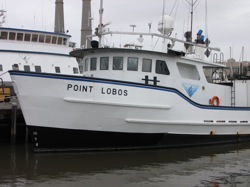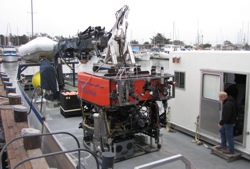
Update: Since this original post, the status of the Point Lobos was updated by Paul Rogers in the San Jose Mercury News. The article also adds detail on the finances of MBARI and its primary funder.
The Monterey Bay Aquarium Research Institute (MBARI) has been forced to dock the workhorse of its research fleet, the R/V Point Lobos.
For years the vessel has ventured out three-to-five times a week, to conduct short-term experiments in the deep canyons of Monterey Bay. The ship serves as a platform for the Institute’s remote-control submarine, ROV Ventana. The Point Lobos and its robo-sub have played critical roles in recent experiments to study the effects of ocean acidification, among other endeavors.
In the late 1980s, MBARI converted the 110-foot vessel from its original duty as an oilfield service boat in the Gulf of Mexico. Since then it’s completed more than 3,500 missions, with its seven-person crew and various teams of scientists.

Institute spokesman Kim Fulton-Bennett says that as of April 1, the Lobos is “mothballed” for the time being, its future uncertain. “It means we won’t have as frequent access to the ocean as we did,” Fulton-Bennett told me, as we stood on the dock at Moss Landing.
“By going out several times a week, we’ve got a database of observations that goes back 20 years.”
But the Wall Street woes of the past couple of years have taken their toll on the investment portfolios of many foundations, including MBARI’s primary funder, the David and Lucile Packard Foundation, which Fulton-Bennett says has reduced it’s funding for MBARI.
H-P co-founder David Packard launched MBARI in 1987 with the goal of applying advanced technology to marine research. The Institute relies on the Packard Foundation for 80% of its funding, typically $30-to-40 million per year, according to the MBARI annual report.
The Institute has two other vessels in its research fleet, a converted pilot boat called the Zephyr and the 117-foot Western Flyer, a twin-hulled, ultra-stable vessel that resembles a catamaran-style ferry. The Flyer is deployed on longer-duration missions in open sea, usually with project-specific funding.
The Point Lobos is featured in Lauren Sommer’s radio report/audio slide show for KQED’s Quest series.
